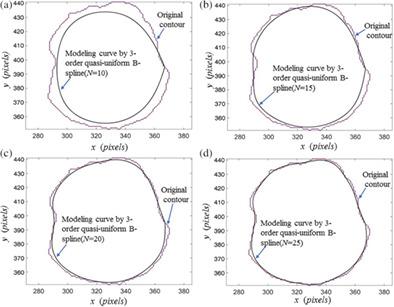当前位置:
X-MOL 学术
›
Microsc. Res. Tech.
›
论文详情
Our official English website, www.x-mol.net, welcomes your feedback! (Note: you will need to create a separate account there.)
Contours modeling of fascicular groups from micro-computed tomography images of peripheral nerves
Microscopy Research and Technique ( IF 2.5 ) Pub Date : 2021-05-28 , DOI: 10.1002/jemt.23840 Yingchun Zhong 1 , Jian Qi 2 , Fang Li 3 , Siyu Sun 1 , Shuang Zhu 4 , Chao Wang 1 , Peng Luo 5
Microscopy Research and Technique ( IF 2.5 ) Pub Date : 2021-05-28 , DOI: 10.1002/jemt.23840 Yingchun Zhong 1 , Jian Qi 2 , Fang Li 3 , Siyu Sun 1 , Shuang Zhu 4 , Chao Wang 1 , Peng Luo 5
Affiliation

|
The objective is to explore the appropriate method to establish the mathematical model of fascicular groups' contours from micro-CT images of peripheral nerves during the nonsplitting/merging phase. The original contours of fascicular groups from the micro-CT image were described as the discrete pixel points. All discrete pixel points of shapes were extracted into a data set through image processing. The data set was modeled by Bezier, B-spline method, respectively, in which each discrete point was used as a control point for modeling. In the Bezier method, the contour of a nerve bundle needs more than two different Bezier curves to model, making the junction points between two models discontinuous. The contour model described by B-spline is very close to the original contour of nerve bundles when all discrete points are used as the control points. The models described by B-spline have different terms and parameters, making it difficult to calculate in the following research. When the third-order quasi-uniform B-spline method is employed, all nerve bundles models have the same number of terms. The modeling error of third-order quasi-uniform B-spline is less than 3% when the Dice coefficient is more than 95%, and the appropriate number of sampling times is 21. The modeling accuracy is improved with increased sampling times when it is less than 21. However, the modeling accuracy remains stable while the number of sampling times is more than 21. The third-order quasi-uniform B-spline is more efficient in modeling nerve bundles' contour, which is more accurate and straightforward.
中文翻译:

从周围神经的显微计算机断层扫描图像对束状群进行轮廓建模
目的是探索在非分裂/合并阶段从周围神经的显微CT图像中建立束状群轮廓的数学模型的适当方法。来自微 CT 图像的束状群的原始轮廓被描述为离散像素点。通过图像处理,将形状的所有离散像素点提取为数据集。数据集分别采用Bezier、B-spline方法建模,其中每个离散点作为控制点进行建模。在贝塞尔方法中,神经束的轮廓需要两个以上不同的贝塞尔曲线来建模,使得两个模型之间的连接点不连续。当所有离散点都作为控制点时,B样条描述的轮廓模型与神经束的原始轮廓非常接近。B-spline 描述的模型具有不同的项和参数,使得在后续研究中难以计算。当采用三阶准均匀 B 样条方法时,所有神经束模型具有相同的项数。当Dice系数大于95%时,三阶准均匀B样条的建模误差小于3%,合适的采样次数为21次。建模精度随着采样次数的增加而提高小于21。但在采样次数大于21时建模精度保持稳定。三阶准均匀B样条对神经束轮廓建模更有效,
更新日期:2021-05-28
中文翻译:

从周围神经的显微计算机断层扫描图像对束状群进行轮廓建模
目的是探索在非分裂/合并阶段从周围神经的显微CT图像中建立束状群轮廓的数学模型的适当方法。来自微 CT 图像的束状群的原始轮廓被描述为离散像素点。通过图像处理,将形状的所有离散像素点提取为数据集。数据集分别采用Bezier、B-spline方法建模,其中每个离散点作为控制点进行建模。在贝塞尔方法中,神经束的轮廓需要两个以上不同的贝塞尔曲线来建模,使得两个模型之间的连接点不连续。当所有离散点都作为控制点时,B样条描述的轮廓模型与神经束的原始轮廓非常接近。B-spline 描述的模型具有不同的项和参数,使得在后续研究中难以计算。当采用三阶准均匀 B 样条方法时,所有神经束模型具有相同的项数。当Dice系数大于95%时,三阶准均匀B样条的建模误差小于3%,合适的采样次数为21次。建模精度随着采样次数的增加而提高小于21。但在采样次数大于21时建模精度保持稳定。三阶准均匀B样条对神经束轮廓建模更有效,



























 京公网安备 11010802027423号
京公网安备 11010802027423号